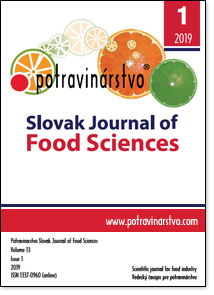The electrical conductivity of sheep's milk and the possibility of mastitis detection
DOI:
https://doi.org/10.5219/1074Keywords:
Electric Conductivity, Somatic Cell Count, Sheep Milk, MastitisAbstract
Measurement of electrical conductivity (EC) is a method frequently used in dairy cows during milking in milking parlours, but especially in robotic milking as a low-cost mastitis detection method. The aim of this study was to evaluate the relationship between somatic cell count (SCC) and EC of milk in sheep reared in Slovakia as factors for monitoring subclinical mastitis on the basis of a bacteriological examination of udder health. Samples were collected individually from both halves of the udder from 295 sheep of different breeds from eight farms during evening milking. Based on SCC, the samples (590) were divided into classes (SCC < 2 × 105, 2 × 105 ≤ SCC < 4 × 105, 4 × 105 ≤ SCC < 6 × 105, and SCC ≥ 6 × 105 cells.mL-1), (SCC < 7 × 105 and SCC ≥ 7 × 105 cells.mL-1) and (SCC < 1 × 105 and SCC ≥ 1 × 105 cells.mL-1) respectively. Based on the presence of pathogens in the udder halve, they were classified as “major pathogens” (14), “minor pathogens” (161) and “without pathogens” (415). The presence of a pathogen had a significant effect on the increase in EC, SCC and protein content and decrease in content of lactose. We found a significant correlation between EV and SCC at first classification only in cases where all data was analysed jointly (r = 0.531), SCC ≥ 6 × 105 (r = 0.403) and SCC < 2 × 105 (r = 0.214). In the second and third classification, we found significant correlations in both cases, the SCC < 7 × 105 (r = 0.270) and the SCC ≥ 7 × 105 (r = 0.382) and SCC < 1 × 105 (r = 0.136) and the SCC ≥ 1 × 105 (r = 0.557). The electrical conductivity showed a stronger correlation with the lactose and protein content than LogSCC. We can argue that measuring the electrical conductivity of sheep milk may be a possible alternative for mastitis detection in sheep. EC can be useful in detecting animals with level of SSC greater than 6 × 105 cells.mL-1.
Downloads
Metrics
References
Abdelgawad, A. R., Rovai, M., Caja, G., Leitner, G., Castillo, M. 2016. Evaluating coagulation properties of milk from dairy sheep with subclinical intramammary infection using near infrared light scatter. A preliminary study. Journal of Food Engineering, vol. 168, p. 180-190. https://doi.org/10.1016/j.jfoodeng.2015.07.018 DOI: https://doi.org/10.1016/j.jfoodeng.2015.07.018
Baranovič, Š., Tančin, V., Tvarožková, K., Uhrinčať, M., Mačuhová, L., Palkovič, J. 2018. Impact of somatic cell count and lameness on the production and composition of ewe’s milk. Potravinarstvo Slovak Journal of Fodd Sciences, vol. 12, no. 1, p. 116-122, https://doi.org/10.5219/900 DOI: https://doi.org/10.5219/900
Barth, K., Burow, E., Knappstein, K. 2008. EC and CMT detect subclinical mastitis in dairy sheep but less sensitive than in dairy cows. Landbauforschung Volkenrode, vol. 58, no. 1/2, p. 65-69.
Caria, M., Chessa, G., Murgia, L., Todde, G., Pazzona, A. 2016. Development and test of a portable device to monitor the health status of Sarda breed sheep by the measurement of the milk electrical conductivity. Italian Journal of Animal Science, vol. 15, no. 2, p. 275-282. https://doi.org/10.1080/1828051X.2016.1149742 DOI: https://doi.org/10.1080/1828051X.2016.1149742
Ferrero, F. J., Valledor, M., Campo, J. C. 2014. Screening method for early detection of mastitis in cows. Measurement, vol. 47, p. 855-860. https://doi.org/10.1016/j.measurement.2013.10.015 DOI: https://doi.org/10.1016/j.measurement.2013.10.015
Gonzalo, C. 2018. Milk hygiene in small ruminants: A review. Spanish Journal of Agricultural Research, vol. 15, no. 4, p. 1-20. https://doi.org/10.5424/sjar/2017154-11727 DOI: https://doi.org/10.5424/sjar/2017154-11727
Kitchen, B. J. 1981. Bovine mastitis: milk compositional changes and related diagnostic tests. Journal of Dairy Research, vol. 48, no. 1, p. 167-188. https://doi.org/10.1017/S0022029900021580 DOI: https://doi.org/10.1017/S0022029900021580
Linage B, García-Jimeno M. A., Juárez M. T., Crespo F. J., Gonzalo C. 2017. Etiología, recuento celular, prevalencia de lesiones mamarias y pérdidas productivas en mamitis subclínicas con severas respuestas inflamatorias en ovino lechero. Proc XLII SEOC Congress, Alcalde MJ (coord.), Consejería de Agricultura Publ, Junta de Castilla y León, Salamanca, Spain, p. 301-306.
Olechnowicz, J., Jaśkowski. J. M., Antosik, P., Bukowska, D. 2009. Milk yield and composition in line 05 dairy ewes as related to somatic cell counts. Journal of Animal and Feed Sciences, vol. 18, no. 3, p. 420-428. https://doi.org/10.22358/jafs/66417/2009 DOI: https://doi.org/10.22358/jafs/66417/2009
Peris, C., Molina, P., Fernandez, N., Rodriguez, M., Torres, A. 1991. Variation in Somatic Cell Count, California Mastitis Test, and Electrical Conductivity Among Various Fractions of Ewe's Milk1. Journal of dairy science, vol. 74, no. 5, p. 1553-1560. https://doi.org/10.3168/jds.S0022-0302(91)78317-3 DOI: https://doi.org/10.3168/jds.S0022-0302(91)78317-3
Romero, G., Roca, A., Alejandro, M., Muelas, R., Díaz, J. R. 2017. Relationship of mammary gland health status and other noninfectious factors with electrical conductivity of milk in Manchega ewes. Journal of dairy science, vol. 100, no. 2, p. 1555-1567. https://doi.org/10.3168/jds.2016-11544 DOI: https://doi.org/10.3168/jds.2016-11544
Scharch, C., Süß, R., Fahr, R. D. 2000, November. Factors affecting milk traits and udder health in East Friesian milk sheep. In Dairy Sheep Symposium. p. 117-128.
Tančin, V., Uhrinčať, M., Mačuhová, L., Baranovič, Š., Vršková, M. 2017. Somatic cell count in milk of individual lacaune ewes under practical conditions in slovakia: possible effect on milk yield and its composition. Potravinarstvo Slovak Journal of Food Sciences, vol. 11, 2017, no. 1, p. 386-390. https://doi.org/10.5219/767 DOI: https://doi.org/10.5219/767
Published
How to Cite
Issue
Section
License
This license permits non-commercial re-use, distribution, and reproduction in any medium, provided the original work is properly cited, and is not altered, transformed, or built upon in any way.






























